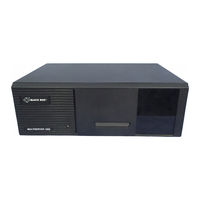Black Box MX226C Multiserver Converter Manuals
Manuals and User Guides for Black Box MX226C Multiserver Converter. We have 2 Black Box MX226C Multiserver Converter manuals available for free PDF download: User Manual, Installation And Operation Manual
Black Box MX226C User Manual (268 pages)
Table of Contents
-
-
Feeder Muxes22
-
The Commpak24
-
-
LCD Display38
-
-
-
Quick Setup60
-
-
Overview62
-
-
-
The Mux Link77
-
-
-
Classes120
-
-
DTR Protocol126
-
-
Reset132
-
Keypad Reset132
-
-
The Command Mode135
-
Messages142
-
Alarm Messages142
-
Event Messages142
-
Class Messages142
-
-
-
Multiserver
143-
Dialog Messages143
-
Network Security146
-
Passwords146
-
-
-
Reset156
-
-
-
12 Diagnostics
159-
Self-Test159
-
Terminate Test159
-
-
Local Echo159
-
Remote Echo159
-
Local Fox160
-
Remote Fox160
-
-
-
Voice/Fax Tests164
-
LED Test164
-
Memory Dump164
-
Multiserver165
-
-
13 Lcd/Keypad
167-
-
Keypad Reset168
-
Timeouts168
-
Channel Numbers170
-
Menu Functions171
-
Administration171
-
System171
-
Voice/Fax171
-
Busy Mode172
-
Local Node ID172
-
-
Diagnostics173
-
System173
-
Voice/Fax174
-
Integral Devices176
-
-
Configuration176
-
-
-
-
-
Channel Features215
-
-
Dlc216
-
Rts/Cts217
-
Sync-Pad217
-
H-P Sync218
-
Micom Dlc218
-
MICOM Voice218
-
Tdm219
-
Fast Packet219
-
Multiserver220
-
Voice/Fax Module220
-
KTS Interface220
-
E&M Interface220
-
OPX Interface220
-
-
NMS Module222
-
Command Port222
-
-
-
LCD Messages236
-
Lcd Messages237
-
-
CCM Indicators241
-
CEM Indicators243
-
-
Glossary
254
Advertisement
Black Box MX226C Installation And Operation Manual (268 pages)
Table of Contents
-
Introduction23
-
Feeder Muxes24
-
The Commpak26
-
String34
-
Star35
-
Quick Setup62
-
Overview64
-
Thinnet72
-
The Test73
-
The Mux Link80
-
Channels85
-
Calls85
-
Channel Features103
-
Classes124
-
Planning a Class126
-
DTR Protocol130
-
Administration136
-
Keypad Reset136
-
Reset136
-
The Command Mode139
-
Alarm Messages146
-
Messages146
-
Event Messages146
-
Class Messages146
-
Dialog Messages147
-
Network Security150
-
Passwords150
-
Reset160
-
Diagnostics162
-
Self-Test162
-
Terminate Test162
-
Local Echo162
-
Remote Echo162
-
Local Fox163
-
Remote Fox163
-
Voice/Fax Tests167
-
LED Test167
-
Memory Dump167
-
Menu Functions174
-
Administration174
-
Diagnostics176
-
Integral Devices179
-
Configuration179
-
Dialog Messages217
-
Channel Features218
-
Dlc219
-
Rts/Cts220
-
Sync-Pad220
-
H-P Sync221
-
Micom Dlc221
-
MICOM Voice221
-
Tdm222
-
Fast Packet222
-
Voice/Fax Module223
-
KTS Interface223
-
E&M Interface223
-
OPX Interface223
-
NMS Module225
-
Command Port225
-
Message Type226
-
LCD Messages240
-
CCM Indicators244
-
CEM Indicators246
-
Tandem250
-
Hp Enq/Ack250
-
Glossary254
-
Banner Message266
-
Menu Function266
Advertisement

